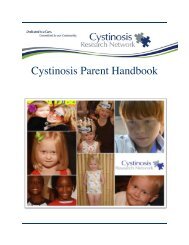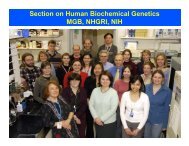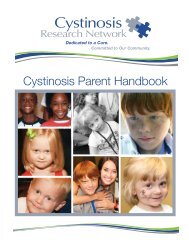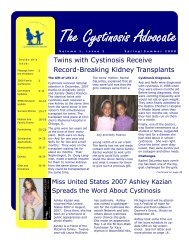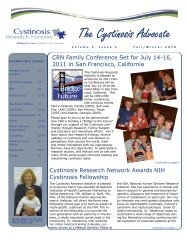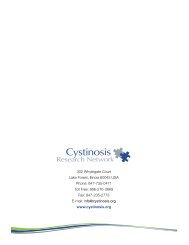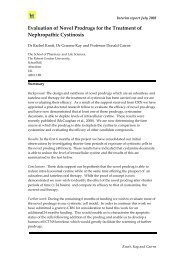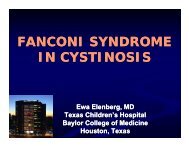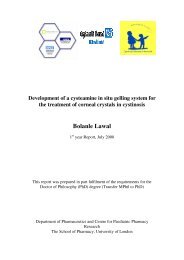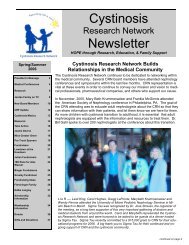Cystinosis Newsletter - Cystinosis Research Network
Cystinosis Newsletter - Cystinosis Research Network
Cystinosis Newsletter - Cystinosis Research Network
You also want an ePaper? Increase the reach of your titles
YUMPU automatically turns print PDFs into web optimized ePapers that Google loves.
Page 11 The <strong>Cystinosis</strong> <strong>Research</strong> <strong>Network</strong> Fall/Winter 2006<br />
continued from page 10<br />
<strong>Cystinosis</strong> <strong>Research</strong> Update<br />
Following sacrifice, we evaluated the liver transduction efficiency by FACS analysis (GFP expression)<br />
and by immunofluorescence studies (GFP expression or using an anti-cystinosin antibody). We<br />
evaluated cystine clearance using the radio-competition cystine binding protein assay. Following injection<br />
of 9 month-old mice, we did not reduce cystine levels with any vector 1 week post-injection<br />
despite a 70% transduction efficiency. In contrast, following injection of 2 month-old mice, we reduced<br />
cystine levels with the hAd-CTNS vector despite a lower transduction efficiency. We are currently<br />
repeating the injections of 2 month-old mice to confirm these data and we will also inject an<br />
intermediate age (6 months).<br />
ii) Eye gene transfer<br />
Our in vitro data suggests that cystine reduction is age-dependent, thus a spatial and temporal guide<br />
of the ocular anomalies in the Ctns -/- mice is a necessary prelude to in vivo gene transfer studies. We<br />
recently finished the biochemical, histological and clinical characterisation of the ocular anomalies in<br />
Ctns -/- mice.<br />
Biochemical assay: We dissected the mouse eye into cornea, iris (plus ciliary body), neural retina<br />
and lens, and analysed the cystine levels in each tissue versus age (1, 3, 5, 7, 9, 11, 13, 15-17, 19-<br />
21 & 23-25 months). We detected elevated cystine levels in the iris (including the ciliary body) of<br />
Ctns -/- mice from 1 month compared to wild-type mice, and in the cornea and retina from 3 months.<br />
For the lens, a significant difference was seen from 5 months. The comparison of cystine accumulation<br />
for different Ctns -/- tissues showed that cystine levels in the cornea and iris were globally the<br />
highest and increased at a greater rate with age. Cystine levels increased dramatically between 5<br />
and 7 months, peaked at 9 months with levels 90- and 260-fold over wild-type for the cornea and iris,<br />
respectively; cystine levels were relatively stable from thereon. By comparison, retinal cystine levels<br />
increased less dramatically with age and at 9 months were 70-fold over wild-type. Finally, the lens<br />
contained the lowest cystine levels: 6-fold over wild-type at 9 months and reaching a maximum of 30fold<br />
at 23 months.<br />
Histological study: We screened for the presence of cystine crystals and lesions versus age (1, 3,<br />
5, 7, 9, 11, 13, 15, 19 and 22 months). We detected rare cystine crystals in the iris and ciliary body<br />
from 1 month. The number of crystals increased with age and became abundant from 7 months.<br />
Moreover, in 19 and 22 month-old Ctns -/- mice, we noted a fusion of the iris and cornea. In contrast to<br />
the iris and ciliary body, we did not detect corneal crystals at 1 month of age. The corneal crystals<br />
appeared from 3 months and were located within the keratocytes and distributed throughout the corneal<br />
stroma. We did not detect cystine crystals in the epithelium, Bowman’s layer, endothelium or<br />
Descemet’s membrane. Finally, in addition to the anterior synechiae, a vascularization of the cornea<br />
was also visible from 19 months.<br />
In the choroid and sclera, we first detected cystine crystals from 3 and 5 months, respectively, and<br />
their number also increased with age, but at a slower rate. In addition, from 7 months the choroid of<br />
Ctns -/- mice was thinner and less homogenous than that of Ctns +/+ controls and continued to degenerate<br />
with age. Up to at least 15 months, we could not detect crystals in the retina and both the neural<br />
retina and the retinal pigment epithelium (RP) retained a homogeneous appearance in Ctns +/+ and<br />
Ctns -/- mice. In contrast, in the 19 and 22 month-old Ctns -/- mice, the RP showed signs of degeneration.<br />
Moreover, the photoreceptor segments and nuclei were absent and the inner nuclear layer constituted<br />
the most posterior layer of the neural retina and contained rare crystals. Finally, we could not<br />
detect cystine crystals in the lens at any age.<br />
continued on page 11



